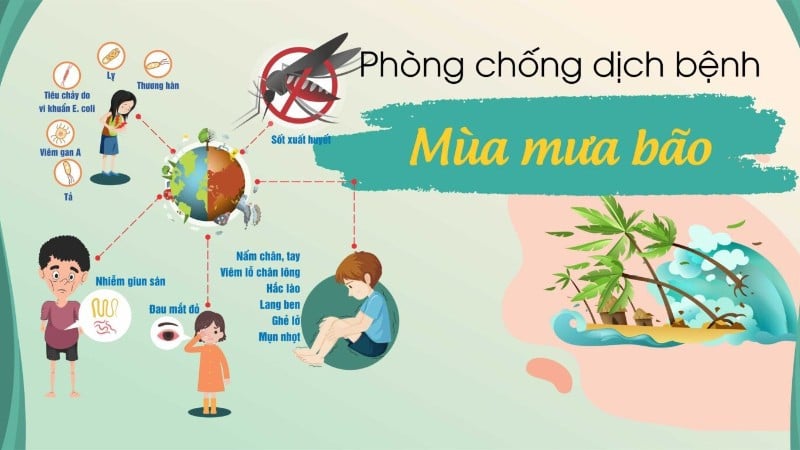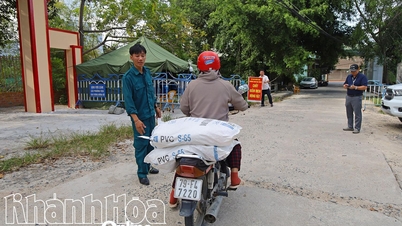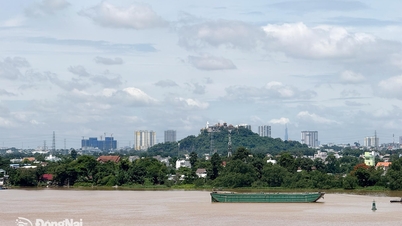
Storms and floods not only cause damage to property and traffic, but also bring many health risks, especially infectious diseases. During storms and floods, maintaining environmental hygiene and controlling infections play an extremely important role not only in the community but also in medical facilities.
Dr. Truong Anh Thu shared some knowledge and recommendations to help people and medical facilities proactively prevent epidemics during and after storms and floods.
Risk of infection after storm
After storms and floods, the living environment is often heavily polluted. Flood water, garbage, animal carcasses, clogged drainage systems… create favorable conditions for bacteria and viruses to develop.
Accordingly, common diseases after storms include: Respiratory diseases (pneumonia, flu, Covid-19) with the highest rate after natural disasters due to large crowds in evacuation areas, insufficient ventilation and transmission through droplets; diarrhea, hepatitis A/E, cholera, typhoid due to use of contaminated water or food.
In addition, people are at risk of skin infections, tetanus due to wounds coming into contact with dirty water or mud; diseases caused by mosquitoes and rodents such as dengue fever, malaria, and leptospirosis (rat-borne disease).
The risks of mold and food contamination often occur within 48 hours of an area being flooded due to compromised food storage and disruption of the supply chain of infection control supplies.
Dr. Truong Anh Thu emphasized that proactively controlling infections in natural disasters from the beginning can prevent epidemics and protect health.
To minimize the impact of storms/floods on patients and the environment, it is necessary to have an emergency response plan to control the risk of infection, ensuring the following principles: Prioritize easy-to-understand measures that can be implemented quickly anytime, anywhere; flexibly adapt to different circumstances, especially in conditions of water shortage and power outage.
It is necessary to assess the risk of infection to intervene in targeted infection control. High risk applies to critically ill patients who need immediate resuscitation due to the risk of hospital-acquired infection. In addition, it is important to note that the elderly, children, pregnant women and people with chronic diseases are vulnerable groups and need special protection.
According to this expert, in medical facilities, especially during the storm and flood season, ensuring a sterile environment is a top priority, a “living shield”. “In the context of storms and floods, even a small mistake in hygiene can lead to cross-infection, affecting seriously ill patients. Therefore, medical staff need to strictly maintain procedures from screening, isolation, environmental sanitation to waste treatment.
Specific measures in hospitals, medical facilities as well as quarantine areas, evacuation areas, and residential areas
According to Dr. Truong Anh Thu, the hospital needs to conduct screening as soon as a patient moves in from a storm-hit area or develops the disease during their stay. Screen people with symptoms such as fever, cough, rash, open wounds, vomiting, or diarrhea. Transfer patients at risk of infection to an isolation area or separate area.
Health care workers should use appropriate personal protective equipment when caring for sick patients. Tetanus or other vaccinations should be administered as needed.
" Hand hygiene is the most important measure. If there is clean water, everyone should wash their hands with soap. If not, use an alcohol-based sanitizer. When to wash hands: Before eating and after using the toilet, after handling garbage, cleaning water," Dr. Thu emphasized.

One important thing to note for people in flood-affected areas is the need to clean the water source. Bacterial contamination in water poses a great health risk. Therefore, it is necessary to boil water for at least 1 minute before drinking. If clean water is not available, you can mix 1/8 teaspoon of chlorine bleach (odorless, containing 5.25% sodium hypochlorite) for every 3.8 liters of water. Active chlorine usually inactivates more than 99.99% of intestinal bacteria and viruses. Well water needs to be cleaned and disinfected with chlorine solution. Wait at least 48 hours after disinfection to test the water (for coliform bacteria and E. coli) before using.
Food should be kept dry and covered, and refrigerated food should be discarded if left at room temperature for more than 2 hours. People with symptoms of infectious diseases (such as cholera, dysentery, typhoid, hepatitis A/E, diarrhea) should not prepare or serve food.
Enhance surface disinfection, prioritizing flooded areas. Especially treat the environment immediately to avoid creating conditions for mold growth.
Provide adequate personal protective equipment (PPE) for anyone involved in cleanup or exposed to floodwater. Avoid touching your face or mouth with dirty hands. Anyone injured during cleanup should have their wound treated immediately and be assessed for tetanus vaccination.
Properly handle waste and corpses to avoid spreading pollution; remediate and monitor after storms, daily monitor for unusual signs (fever, rash, diarrhea, skin infections...) to detect early risks of epidemics.
When the water recedes, it is extremely necessary to thoroughly clean and disinfect the entire living area, hospital, and school. Clean the floor, walls, and utensils, disinfect with a diluted chlorine solution (0.1%-0.5%). Treat mold and insects, check and clean the ventilation system to ensure natural ventilation. Check the water source, waste treatment system, dining room, restroom, etc.
During the storm and flood season, in addition to protecting property and lives, people also need to pay attention to their health and avoid being subjective about infection problems. Keeping hands clean, water clean, and food clean is to keep yourself, your family and the community safe.
Source: https://nhandan.vn/chu-dong-kiem-soat-nhiem-khuan-trong-mua-bao-lu-post913677.html



![[Photo] Closing of the 13th Conference of the 13th Party Central Committee](https://vphoto.vietnam.vn/thumb/1200x675/vietnam/resource/IMAGE/2025/10/08/1759893763535_ndo_br_a3-bnd-2504-jpg.webp)



























































































Comment (0)